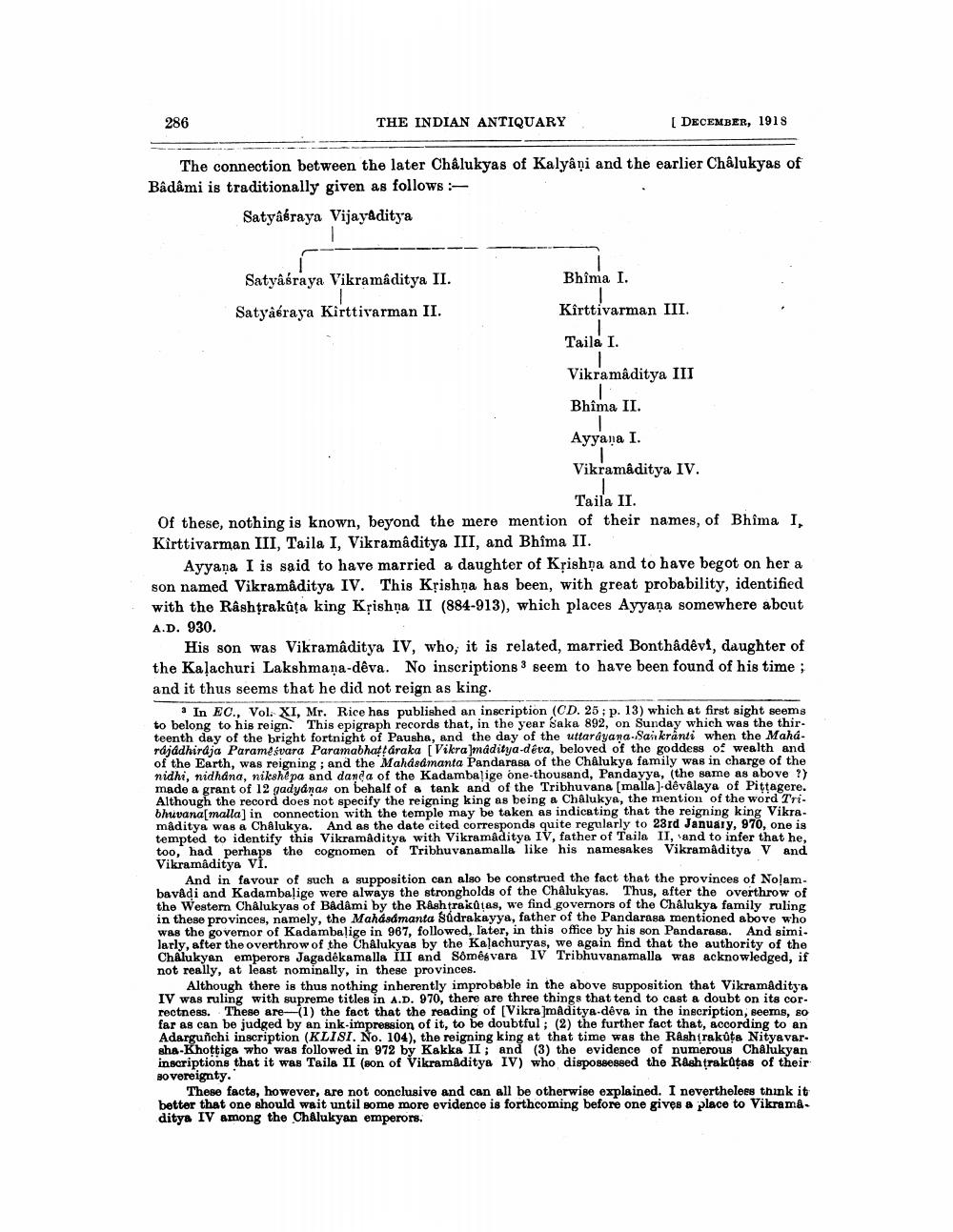________________
286
THE INDIAN ANTIQUARY
[ DECEMBER, 1918
The connection between the later Châlukyas of Kalyani and the earlier Châlukyas of Badâmi is traditionally given as follows
Satyasraya Vijayaditya
Bhima I.
Satyâsraya Vikramaditya II. Satyaéraya Kirttirarman II.
Kîrttivarman III. Taila I.
Vikramaditya III
Bhîma II. Ayyana I.
Vikramaditya IV.
Taila II. Of these, nothing is known, beyond the mere mention of their names, of Bhima I. Kirttivarman III, Taila I, Vikramaditya III, and Bhima II.
Ayyana I is said to have married a daughter of Kțishna and to have begot on her a son named Vikramaditya IV. This Krishna has been with great probability, identified with the Rashtrakata king Krishna II (884-913), which places Ayyaņa somewhere about A.D. 930.
His son was Vikramaditya IV, who, it is related, married Bonthâdêvi, daughter of the Kalachuri Lakshmana-dêva. No inscriptions 3 seem to have been found of his time; and it thus seems that he did not reign as king.
In EC., Vol. XI, Mr. Rice has published an inscription (CD. 25; p. 13) which at first sight seems to belong to his reign. This epigraph records that, in the year Saka 892, on Sunday which was the thir. teenth day of the bright fortnight of Pausha, and the day of the uttarayana Saikranti when the Mahardjadhirdja Paramèsvara Paramabhattáraka (Vikramaditya-deva, beloved of the goddess of wealth and of the Earth, was reigning : and the Mahdsamanta Pandarasa of the Chalukya family was in charge of the nidhi, nidhana, nikshë pa and danda of the Kadambalige one-thousand, Pandayya, (the same as above ?) made a grant of 12 gadyanas on behalf of a tank and of the Tribhuvana (malla) dévalaya of Pittagere. Although the record does not specify the reigning king as being a Chalukya, the mention of the word Tri. bhuvana[malla) in connection with the temple may be taken as indicating that the reigning king Vikramaditya was a Chalukya. And as the date cited corresponds quite regularly to 23rd January, 970, one is tempted to identify this Vikramaditya with Vikramaditya IV, father of Taila II, and to infer that he, too, had perhaps the cognomen of Tribhuvanamalla like his namesakes Vikramaditya Vand Vikramaditya VI.
And in favour of such a supposition can also be construed the fact that the provinces of Nolambavâdi and Kadambalige were always the strongholds of the Châlukyas. Thus, after the overthrow of the Western Chalukyas of Badâmi by the Rashtrakūtas, we find governors of the Chalukya family ruling in these provinces, namely, the Mahásámanta Sudrakayya, father of the Pandarasa mentioned above who was the governor of Kadambalige in 967, followed, later, in this office by his son Pandaras. And simi. larly, after the overthrow of the Chalukyas by the Kalachuryas, we again find that the authority of the ChAlukyan emperors Jagadékamalla III and Sómēsvara IV Tribhuvanamalla was acknowledged, if not really, at least nominally, in these provinces.
Although there is thus nothing inherently improbable in the above supposition that Vikramaditya IV was ruling with supreme titles in A.D. 970, there are three things that tend to cast a doubt on its cor. rectness. These are (1) the fact that the reading of (Vikramaditya-deva in the inscription, seems, so far as can be judged by an ink-impression of it, to be doubtful; (2) the further fact that, according to an Adargunchi inscription (KLISI. No. 104), the reigning king at that time was the Rashtrakuta Nityavarsha-Khottiga who was followed in 972 by Kakka II; and (3) the evidence of numerous Chalukyan inscriptions that it was Taila II (son of Vikramaditya IV) who dispossessed the Rashtraktas of their sovereignty.
These facts, however, are not conclusive and can all be otherwise explained. I neverthelees think it better that one should wait until some more evidence is forthcoming before one gives a place to Vikramaditya IV among the Chalukyan emperors.




